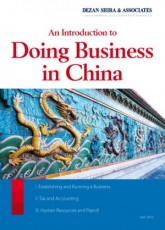Enhanced Legal Protection for Foreign Investors in China

Among key concerns for foreign companies in China is the underdeveloped and at times opaque Chinese legal system. In recent years however, China has been stepping up its legal reforms and is moving ever closer towards strong rule of law. In this article, we summarize some of the recent improvements to China’s legal system affecting foreign investors.
New Interpretation of the Civil Procedure Law
The Supreme People’s Court of China (SPC) recently issued a comprehensive Interpretation of the 2012 Civil Procedure Law. The civil procedure law covers civil litigation, such as contractual disputes between two private entities. The Supreme Court in China regularly publishes these Interpretations to indicate how laws and regulations are to be interpreted. The interpretation of Chinese laws relies strongly on these Interpretation documents issued by the Supreme Court, and less so on case law. The Interpretation took effect on February 1 and consists of 552 articles, exceeding the length of the Civil Procedure Law itself. Below are a few highlights:
- The Interpretation goes into more detail to improve efficiency and procedural justice, further clarifying circumstances when judges should recuse themselves.
- There are more refined rules on evidence, describing how electronic data contained in emails, online chat logs, blogs, text messages, electronic signatures, and domain names can be used as evidence.
- The new regulations include more sophisticated procedural rules for public interest and small claims litigation, for example, providing that an organization must show prima facie evidence of harm to the public interest to initiate public interest litigation.
- The Interpretation also features clearer treatment of foreign documents and rulings, including provisions concerning foreign language evidence and the recognition and execution of foreign rulings, affording litigants more legal certainty in cross-border litigation.
![]() RELATED: China Adopts Decision on Revision of Civil Procedure Law
RELATED: China Adopts Decision on Revision of Civil Procedure Law
Amended Administrative Procedure Law
In November 2014, the National People’s Congress (NPC) of China approved and released the amended Administrative Procedure Law, which will take effect on May 1, 2015. Administrative litigation encompasses most non-criminal procedures between a private party and a government body.
- The new Administrative Procedure Law extends the scope to cover all types of administrative litigation;
- Electronic data is now permitted to be submitted as evidence. Relevant evidence that is not able to be collected by the plaintiff or the third party can be collected directly by the court;
- The revised Administrative Procedure Law requires the plaintiff to initiate legal proceedings within six months from the date of notification of the administrative action, extended from the previous three-month time limit.
- The plaintiff may apply for non-public hearings if the case contains confidential information.
New Trademark Law
In May 2014, the amended Trademark Law came into force, in a move to further strengthen protection of trademarks. Key points in the new Trademark Law are:
- Trademark registrations are to be completed within nine months from the date of application;
- The new law allows sound to be registered as a trademark in China for the first time, embracing the Singapore treaty of 2006; and
- The new law strengthens protection for well-known trademarks and unregistered trademarks while also making it harder for preemptive trademark filers to successfully register in bad faith.
Additionally, the law states that foreign companies are required to entrust a trademark agency to handle the registration. While the protection for unregistered trademarks has been strengthened, it still strongly advisable to file trademarks in China directly and ahead of time when planning to sell products in China.
![]() RELATED: China’s New Trademark Law to Come into Effect May 1
RELATED: China’s New Trademark Law to Come into Effect May 1
Implementation Regulations for the New Trademark Law
Following the new Trademark Law, the State Council released the relevant implementation regulations, which further clarifies issues related to service marks (a trademark used to identify a service rather than a product). A geographical indication can be registered as a certification mark or a collective mark. All the application form and documents must be written in Chinese.
In the case that over two applicants apply to register similar trademarks for the same type of goods on the same day, the applicants should submit evidence which shows the trademark has been used prior to the registration within 30 days from the date of receipt of notice from the trademark bureau. Where the trademark was used on the same day or has not been used by either side before, the applicants may negotiate and send a formal agreement to the trademark bureau within another 30 days. If the applicants are not able to make the decision, the trademark bureau will require the applicants to draw lots to determine who gets the trademark.
The Regulations also strengthen the protection of registered trademark, which stipulated that the use of a mark which is similar to others’ registered trademark on the same type pf goods shall fall under trademark infringement. Based on this rule, foreign exporters should pay high attention when their distributor translate the goods brand name into Chinese, given that all the imported goods into China need to have a Chinese label. If the goods’ Chinese name happens to be the same as a registered trademark in China, it will be regarded as trademark infringement.
Patent Law
In January, the State Intellectual Property Office (SIPO) released a draft of “Measures for Patent Administrative Law Enforcement” which put emphasis on e-commerce platform patent disputes and reduces the time frame for patent litigation. The Draft further clarifies the types of patent disputes and stipulates that design patent disputes should be solved in two months and that invention patent disputes should be solved in three months. China is also on its way to revise the current Patent Law, strengthening protection for design patents.
Intellectual Property Court
In August 2014, the Chinese government approved the establishment of three Intellectual Property courts, in Shanghai, Beijing and Guangzhou. The courts are presided over by senior judges with extensive experience in the fields of intellectual property law and technology.
On March 3 2015, the Nanjing city government released a plan to step up action against IP infringements and announced that it too will set up a dedicated intellectual property court.
Circuit Court of Supreme Court
The Supreme People’s Court has set up circuit courts in Shenzhen in southern China, and Shenyang the capital city of Liaoning province in Northeast China.
The circuit court will serve as the branches of the Supreme Court and will take charge of Hong Kong, Macau and Taiwan related civil and commercial cases. Import-related and inter-provincial cases intellectual property, foreign related commercial cases and state compensation will still be handled by the Supreme Court itself. On March 2, the Shenzhen circuit court heard its first case, a contractual dispute.
|
Asia Briefing Ltd. is a subsidiary of Dezan Shira & Associates. Dezan Shira is a specialist foreign direct investment practice, providing corporate establishment, business advisory, tax advisory and compliance, accounting, payroll, due diligence and financial review services to multinationals investing in China, Hong Kong, India, Vietnam, Singapore and the rest of ASEAN. For further information, please email china@dezshira.com or visit www.dezshira.com. Stay up to date with the latest business and investment trends in Asia by subscribing to our complimentary update service featuring news, commentary and regulatory insight. |
![]()
 Doing Business in China
Doing Business in China
The China Briefing Business Guide to Doing Business in China is the definitive guide to one of the fastest growing economies in the world, providing a thorough and in-depth analysis of China, its history, key demographics and overviews of the major cities, provinces and autonomous regions highlighting business opportunities and infrastructure in place in each region.
 Adapting Your China WFOE to Service China’s Consumers
Adapting Your China WFOE to Service China’s Consumers
In this issue of China Briefing Magazine, we look at the challenges posed to manufacturers amidst China’s rising labor costs and stricter environmental regulations. Manufacturing WFOEs in China should adapt by expanding their business scope to include distribution and determine suitable supply chain solutions. In this regard, we will take a look at the opportunities in China’s domestic consumer market and forecast the sectors that are set to boom in the coming years.
 Annual Audit and Compliance in China In this issue of China Briefing, we discuss annual compliance requirements for foreign-invested enterprises, including wholly-foreign owned enterprises, joint ventures and foreign-invested commercial enterprises, as well as the less demanding requirements for representative offices. We also highlight the most recent tax and legal changes that will significantly influence the way companies do business in China in 2014.
Annual Audit and Compliance in China In this issue of China Briefing, we discuss annual compliance requirements for foreign-invested enterprises, including wholly-foreign owned enterprises, joint ventures and foreign-invested commercial enterprises, as well as the less demanding requirements for representative offices. We also highlight the most recent tax and legal changes that will significantly influence the way companies do business in China in 2014.
- Previous Article China Regulatory Brief: New Rules for VAT General Taxpayers Status, Draft Amendments to Patent Law Released
- Next Article E-commerce Brand Protection in China









